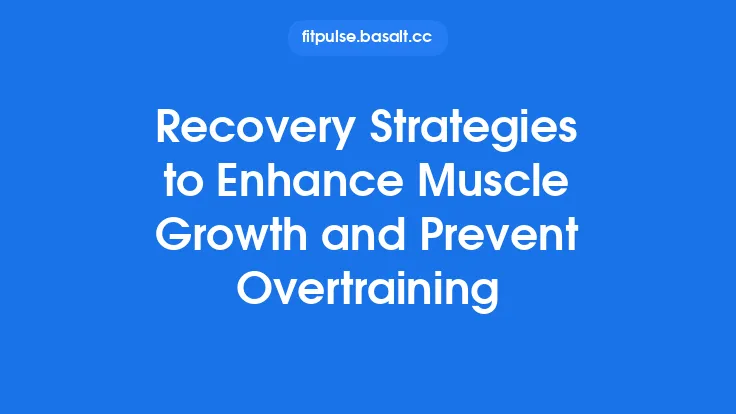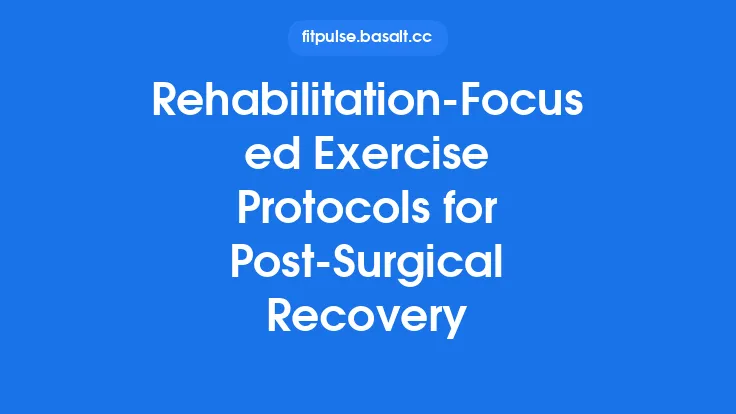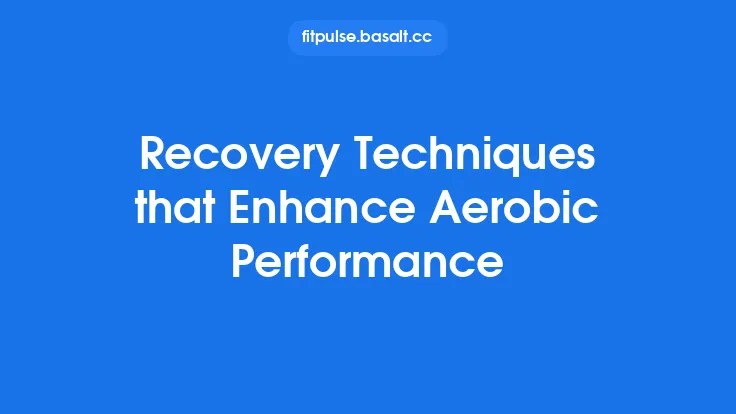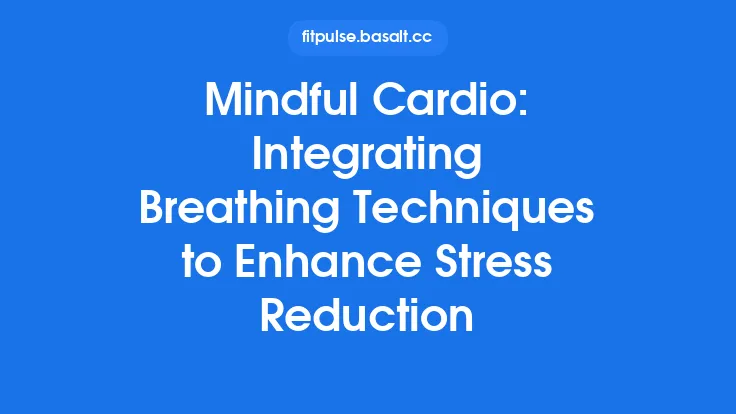Recovering from a workout isn’t just about stretching sore muscles or refueling with the right nutrients; it’s also an opportunity to calm the nervous system, reset mental focus, and promote deeper physiological healing. Guided meditation—structured, intentional mental practice led by a voice, recording, or internal script—offers a powerful, low‑impact tool to accelerate this recovery phase. By directing attention inward, you can lower stress hormones, improve heart‑rate variability, and enhance the body’s natural repair processes, all without needing extra equipment or a large time commitment. Below, we explore the science behind post‑exercise meditation, break down the essential components of an effective guided session, and provide practical, evergreen strategies you can weave into any home‑based fitness routine.
Why Meditation Matters for Recovery
Stress Hormone Regulation
Intense physical activity triggers the release of cortisol and adrenaline, hormones that help you perform but can impede recovery if they remain elevated. Guided meditation activates the parasympathetic nervous system, signaling the body to shift from “fight‑or‑flight” to “rest‑and‑digest.” Studies consistently show that a 10‑ to 20‑minute meditation session can reduce cortisol levels by up to 30 % within an hour after exercise.
Heart‑Rate Variability (HRV) Boost
HRV— the variation in time between heartbeats— is a reliable marker of autonomic balance. Higher HRV indicates a resilient nervous system and better recovery capacity. Meditation, especially when it incorporates gentle body awareness, has been shown to increase HRV, helping the cardiovascular system return to baseline more quickly after strenuous effort.
Neuroplastic Benefits
Repeated meditation strengthens neural pathways associated with attention, emotional regulation, and interoception (the sense of internal bodily states). Over time, this translates into a heightened ability to notice subtle signs of fatigue, inflammation, or tension, allowing you to adjust training loads before injury occurs.
Pain Perception Modulation
Guided imagery and mindfulness practices can alter the brain’s pain matrix, reducing the subjective intensity of post‑exercise soreness. By reframing discomfort as a neutral sensation rather than a threat, you can experience a smoother, more comfortable recovery window.
Physiological Foundations of Post‑Exercise Meditation
| System | Typical Post‑Exercise State | Meditation‑Induced Shift |
|---|---|---|
| Endocrine | Elevated cortisol, catecholamines | Decreased cortisol, balanced insulin sensitivity |
| Autonomic | Sympathetic dominance (↑ heart rate, ↓ HRV) | Parasympathetic activation (↓ heart rate, ↑ HRV) |
| Musculoskeletal | Micro‑tears, inflammatory cytokines | Reduced pro‑inflammatory markers (IL‑6, TNF‑α) |
| Immune | Transient immunosuppression | Enhanced natural killer cell activity |
| Cognitive | Mental fatigue, reduced focus | Improved executive function, clearer mental state |
The transition from a sympathetic to a parasympathetic state is mediated primarily by the vagus nerve. Guided meditation stimulates vagal tone through slow, rhythmic attention to internal sensations, which in turn cascades into the systemic benefits listed above.
Core Elements of an Effective Guided Session
- Intentional Opening
Begin with a brief statement of purpose (e.g., “This session will help your body transition from exertion to restoration”). This frames the mind and signals the nervous system that a shift is occurring.
- Grounding the Body
Encourage the practitioner to feel the contact points—feet on the floor, hands resting on the thighs, the weight of the body against the chair or mat. Grounding anchors attention and reduces wandering thoughts.
- Sensory Scan (Non‑Progressive)
Rather than a progressive muscle relaxation, use a sensory scan that invites awareness of temperature, pressure, and subtle movement without actively tensing or releasing muscles. This respects the neighbor article’s scope while still fostering body awareness.
- Guided Imagery
Visualize the body’s repair processes: imagine blood flowing richly to fatigued muscles, cells regenerating, and a gentle wave of warmth soothing any tightness. Imagery should be vivid but not tied to specific yoga or Pilates movements.
- Emotional Release
Offer a moment to acknowledge any lingering frustration, excitement, or fatigue. Naming emotions reduces their intensity and prevents mental rumination that can keep cortisol elevated.
- Closing Integration
End with a concise affirmation or intention (e.g., “I carry this calm into the rest of my day”). A brief countdown back to the external environment helps transition smoothly from the meditative state.
Sample Guided Meditation Scripts
1. “The Recovery Wave” (10 minutes)
Opening (1 min):
“Find a comfortable seated position. Rest your hands gently on your knees. Close your eyes if you feel safe doing so, and take a natural breath in and out. This time is dedicated to helping your body heal.”
Grounding (2 min):
“Feel the weight of your sit bones on the floor. Notice the contact of your feet with the ground. Imagine tiny roots extending from the soles of your feet, anchoring you to the earth.”
Sensory Scan (2 min):
“Shift your attention to the sensations in your legs. Notice any warmth, tingling, or subtle throbbing. Observe without judgment, simply noting what is present.”
Guided Imagery (3 min):
“Picture a gentle, golden light flowing into the muscles you just exercised. As this light moves, it carries oxygen and nutrients, repairing microscopic tears. See the light dissolve any lingering stiffness, leaving a feeling of softness.”
Emotional Release (1 min):
“Now, bring to mind any emotions that arose during your workout—perhaps pride, fatigue, or frustration. Acknowledge them, then let them drift away like clouds across a sky.”
Closing (1 min):
“Take a final deep breath, feeling gratitude for your body’s effort. When you’re ready, gently open your eyes, carrying this sense of renewal into the rest of your day.”
2. “Heart‑Center Calm” (15 minutes)
Opening: “Sit or lie down in a place where you won’t be disturbed. Place one hand over your heart and the other on your abdomen.”
Grounding: “Feel the surface supporting you. Notice the rise and fall of your chest with each breath, allowing the rhythm to become your anchor.”
Sensory Scan: “Direct attention to the pulse you feel under your hand. Observe its speed, strength, and any subtle variations.”
Guided Imagery: “Imagine each heartbeat as a tiny drum, sending waves of restorative energy through your bloodstream. Visualize these waves reaching every muscle, delivering repair and calm.”
Emotional Release: “If thoughts of the workout linger—‘Did I push hard enough?’—let them surface, then gently set them aside, trusting that your body knows what it needs.”
Closing: “Take three slow breaths, feeling the calm settle in your chest. When you’re ready, bring your awareness back to the room, and gently move.”
Integrating Meditation into Your Recovery Routine
| Timing | Recommended Approach | Rationale |
|---|---|---|
| Immediately post‑workout (0‑5 min) | Short 3‑5 min grounding + sensory scan | Helps transition the nervous system before cortisol spikes. |
| After cool‑down stretch (5‑15 min) | Full 10‑15 min guided session | Allows muscles to stay warm, enhancing imagery of blood flow. |
| Evening (30‑60 min after dinner) | 15‑20 min meditation + light journaling | Supports sleep quality, which is critical for tissue repair. |
| On rest days | 20‑30 min longer meditation focusing on gratitude and future intentions | Reinforces habit formation and mental resilience. |
Practical Tips
- Consistency Over Length: A daily 5‑minute practice yields more cumulative benefit than an occasional 30‑minute session.
- Use a Timer: Set a gentle alarm to avoid checking the clock, which can break immersion.
- Maintain a Neutral Posture: Avoid slouching or overly rigid positions; the goal is relaxation, not alignment correction.
- Record Your Own Voice: Personalizing the guide can increase engagement and make the practice feel more intimate.
Tools and Resources for Home Practice
| Tool | How It Supports Recovery Meditation | Suggested Use |
|---|---|---|
| Audio Apps (e.g., Insight Timer, Calm) | Vast libraries of guided sessions, including recovery‑focused tracks. | Search “post‑workout recovery” or “muscle repair meditation.” |
| Portable Bluetooth Speaker | Delivers clear, soothing sound without straining headphones. | Place near your workout area for seamless transition. |
| White‑Noise Machines or Nature Sound Loops | Provides a consistent auditory backdrop that masks distractions. | Use low‑volume rain or forest sounds during the session. |
| Meditation Cushion or Foldable Mat | Offers a comfortable, stable surface for seated practice. | Keep one in a dedicated corner for quick access. |
| Journal or Digital Note‑Taking App | Captures insights, emotions, and perceived recovery outcomes. | Write a brief entry after each session to track patterns. |
Common Pitfalls and How to Avoid Them
- Rushing the Transition
Pitfall: Jumping straight from high‑intensity cardio to meditation without a brief cool‑down.
Solution: Incorporate a 2‑minute low‑intensity movement (e.g., slow walking) before sitting.
- Over‑Analyzing Sensations
Pitfall: Turning the sensory scan into a diagnostic exercise, which can increase anxiety.
Solution: Adopt a “noticing” stance—label sensations (“warm,” “tingling”) without interpreting them.
- Using the Same Script Repeatedly Without Variation
Pitfall: Mental habituation reduces engagement.
Solution: Rotate between at least three different guided recordings or create new imagery each week.
- Allowing External Distractions
Pitfall: Phone notifications or household noise break focus, diminishing parasympathetic activation.
Solution: Activate “Do Not Disturb,” close doors, and inform household members of your meditation window.
- Confusing Meditation with Stretching
Pitfall: Adding active stretches during a guided meditation, which re‑activates sympathetic tone.
Solution: Keep the body still (or only gently breathing) during the meditation portion; save stretching for the cool‑down phase.
Tracking Progress and Measuring Benefits
- Heart‑Rate Variability Apps: Record HRV each morning; look for a gradual upward trend after consistent meditation.
- Perceived Recovery Scale (PRS): Rate your recovery on a 0‑10 scale after each workout; note improvements over weeks.
- Cortisol Saliva Tests (optional): For athletes seeking data, periodic testing can confirm hormonal shifts.
- Subjective Journaling: Document sleep quality, mood, and any changes in muscle soreness. Patterns often emerge that correlate with meditation consistency.
By combining objective metrics (HRV, PRS) with subjective observations, you can fine‑tune the length, timing, and content of your guided sessions for maximal recovery impact.
Adapting Practices for Different Fitness Levels
| Fitness Level | Recommended Session Length | Focus Areas |
|---|---|---|
| Beginner | 5‑10 minutes | Simple grounding, basic sensory awareness, gentle imagery. |
| Intermediate | 10‑15 minutes | Incorporate heart‑center visualization, brief emotional release. |
| Advanced/Competitive | 15‑20 minutes | Deeper imagery of cellular repair, extended gratitude segment, optional post‑meditation journaling. |
Beginners may benefit from a single, soothing voice guiding them through the process, while advanced athletes can experiment with self‑directed scripts that align with specific training cycles (e.g., strength‑focused vs. endurance‑focused sessions).
Making Meditation a Habit
- Anchor to an Existing Cue – Pair the meditation with a routine habit, such as “right after I finish my post‑workout stretch.”
- Start Small – Commit to a 3‑minute session for the first week; increase by 1‑2 minutes each subsequent week.
- Track Consistency – Use a habit‑tracking app or a simple calendar check‑off to visualize streaks.
- Celebrate Milestones – After a month of consistent practice, treat yourself to a new meditation track or a calming tea.
- Reflect on Benefits – Periodically review journal entries and HRV data to reinforce the tangible gains you’re experiencing.
When meditation becomes an automatic part of the recovery loop, it not only speeds physical healing but also cultivates mental resilience, making each subsequent workout feel more purposeful and enjoyable.





